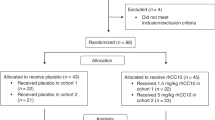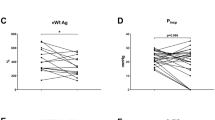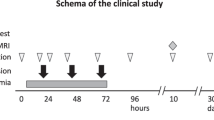Abstract
Clinically apparent pulmonary hemorrhage (PH) occurs in 5% to 7% of very low birth weight (VLBW) infants with respiratory distress syndrome (RDS). It is associated with a mortality rate as high as 50% and significant pulmonary and central nervous system morbidities. There is no consensus on treatment modality. We present two VLBW infants with severe PH that did not respond to conventional treatment but were successfully treated with activated recombinant factor VII (rFVIIa). No untoward side effects were noted.
This is a preview of subscription content, access via your institution
Access options
Subscribe to this journal
Receive 12 print issues and online access
$259.00 per year
only $21.58 per issue
Buy this article
- Purchase on Springer Link
- Instant access to full article PDF
Prices may be subject to local taxes which are calculated during checkout
Similar content being viewed by others
References
Pandit PB, O'Brien K, Asztalos E, Colucci E, Dunn MS . Outcome following pulmonary hemorrhage in very low birthweight neonates treated with surfactant Arch Dis Child Fetal Neonatal Ed 1999 81: F40–4
Tomaszewska M, Stork E, Minich NM, Friedman H, Berlin S, Hack M . Pulmonary hemorrhage: clinical course and outcomes among very low-birth-weight infants Arch Pediatr Adolesc Med 1999 153: 715–21
Raju TN, Langenberg P . Pulmonary hemorrhage and exogenous surfactant therapy: a metaanalysis J Pediatr 1993 123: 603–10
Lusher JM, Roberts HR, Davignon G et al. A randomized, double-blind comparison of two dosage levels of recombinant factor VIIa in the treatment of joint, muscle and mucocutaneous haemorrhages in persons with haemophilia A and B, with and without inhibitors. rFVIIa Study Group Haemophilia 1998 4: 790–8
Hedner U . Recombinant activated factor VII as a universal haemostatic agent Blood Coagul Fibrinolysis 1998 9: Suppl 1 147–52
Berger TM, Allred EN, Van Marter LJ . Antecedents of clinically significant pulmonary hemorrhage among newborn infants J Perinatol 2000 20: 295–300
Garland J, Buck R, Weinberg M . Pulmonary hemorrhage risk in infants with a clinically diagnosed patent ductus arteriosus: a retrospective cohort study Pediatrics 1994 94: 719–23
Thibeault DW, Hall FK, Sheehan MB, Hall RT . Postasphyxial lung disease in newborn infants with severe perinatal acidosis Am J Obstet Gynecol 1984 150: 393–9
Trompeter R, Yu VY, Aynsley-Green A, Roberton NR . Massive pulmonary hemorrhage in the newborn infant Arch Dis Child 1975 50: 123–7
Kluckow M, Evans N . Ductal shunting, high pulmonary blood flow, and pulmonary hemorrhage J Pediatr 2000 137: 68–72
Hedner U . NovoSeven as a universal haemostatic agent Blood Coagul Fibrinolysis 2000 11: Suppl 1 S107–11
Monroe DM, Hoffman M, Oliver JA, Roberts HR . A possible mechanism of action of activated factor VII independent of tissue factor Blood Coagul Fibrinolysis 1998 9: Suppl 1 S15–20
Kjalke M, Ezban M, Monroe DM, Hoffman M, Roberts HR, Hedner U . High-dose factor VIIa increases initial thrombin generation and mediates faster platelet activation in thrombocytopenia-like conditions in a cell-based model system Br J Haematol 2001 114: 114–20
Arkin S, Cooper HA, Hutter JJ et al. Activated recombinant human coagulation factor VII therapy for intracranial hemorrhage in patients with hemophilia A or B with inhibitors. Results of the novoseven emergency-use program Haemostasis 1998 28: 93–8
Chuansumrit A, Chantarojanasiri T, Isarangkura P, Teeraratkul S, Hongeng S, Hathirat P . Recombinant activated factor VII in children with acute bleeding resulting from liver failure and disseminated intravascular coagulation Blood Coagul Fibrinolysis 2000 11: Suppl 1 S101–5
Kristensen J, Killander A, Hippe E et al. Clinical experience with recombinant factor VIIa in patients with thrombocytopenia Haemostasis 1996 26: Suppl 1 159–64
Friederich PW, Wever PC, Briet E, Doorenbos CJ, Levi M . Successful treatment with recombinant factor VIIa of therapy-resistant severe bleeding in a patient with acquired von Willebrand disease Am J Hematol 2001 66: 292–4
Wong WY, Huang WC, Miller R, McGinty K, Whisnant JK . Clinical efficacy and recovery levels of recombinant FVIIa (NovoSeven) in the treatment of intracranial haemorrhage in severe neonatal FVII deficiency Haemophilia 2000 6: 50–4
Duncan A, Benson L, Critz A, Abshire T . Neonatal coagulopathy treatment with rFVIIa Pediatr Res 2001 49: 290A
Shapiro A . Inhibitor treatment: state of the art Semin Hematol 2001 38: 26–34
Author information
Authors and Affiliations
Rights and permissions
About this article
Cite this article
Olomu, N., Kulkarni, R. & Manco-Johnson, M. Treatment of Severe Pulmonary Hemorrhage With Activated Recombinant Factor VII (rFVIIa) in Very Low Birth Weight Infants. J Perinatol 22, 672–674 (2002). https://doi.org/10.1038/sj.jp.7210787
Published:
Issue Date:
DOI: https://doi.org/10.1038/sj.jp.7210787
This article is cited by
-
Recombinant Activated Factor VIIa (rFVIIa) Treatment in Very-Low-Birth-Weight (VLBW) Premature Infants with Acute Pulmonary Hemorrhage: A Single-Center, Retrospective Study
Pediatric Drugs (2017)
-
Recombinant activated factor VIIa treatment for refractory hemorrhage in infants
Journal of Perinatology (2011)
-
Recombinant Activated Factor VII Usage in Life Threatening Hemorrhage: A Pediatric Experience
The Indian Journal of Pediatrics (2011)
-
Recombinant activated factor seven in acute life-threatening bleeding in neonates: report on three cases and review of literature
Journal of Perinatology (2006)
-
Subclinical chorioamnionitis: an unrecognised risk factor for severe pulmonary haemorrhage in extremely low birth weight infants
European Journal of Pediatrics (2005)



